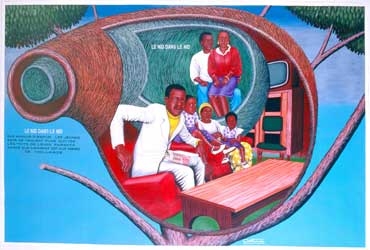| JAPANCONGO - The Art Newspaper |
Jean Pigozzi, the avuncular, forthright, Paris-born collector, often seen on the biennial and art fair circuit, has made his mark on the art world by amassing, over the past 20 years, the world’s largest collection of contemporary African art. (The Tate recently approached the investor in venture capital for advice on establishing an African art collection.) Pigozzi is set to reveal his new collecting obsession in a show opening at Magasin Centre National d’Art Contemporain in Grenoble this month (6 February -24 April): “JapanCongo” presents a selection of works by emerging Japanese artists acquired by Pigozzi in the past three years—over 500 in total— alongside pieces from key Congolese artists. That’s not the only surprise development: Pigozzi’s choice of curator is none other than Carsten Höller, the erudite, Brussels-born artist with a doctorate in agricultural sciences, known for his “Test Site” slides that dominated Tate Modern’s Turbine Hall in 2006. “We met in Monaco last summer and clicked,” said Pigozzi. “When I said that I’d like to show my Japanese art alongside the African works, Höller said: ‘Are you mad?’ But he came to my warehouse in Geneva and was won over.
There is much more to Japanese contemporary art than Takashi Murakami and manga,” said Pigozzi, who has nevertheless befriended the superstar Japanese artist, visiting Murakami’s Geisai fair in Tokyo three years ago and contemporary art galleries in the capital.
Pigozzi stresses that Höller was given “100% free rein” when making his selection of 16 Congolese artists, including Pierre Bodo, Pathy Tshindele, Cheik Ledy, Jean Depara and Chéri Samba.
Some of these in-your-face, mainly figurative works present pivotal political figures such as Nelson Mandela (Cheik Ledy, Nelson Mandela, 1990) and Joseph-Désiré Mobutu, the controversial President of Zaire (now the Democratic Republic of Congo, DCR) from 1965 to 1997 (Maitre Syms, Rétrospective de la RDC, 2001).
Sixteen Japanese artists—from Natsumi Nagao to Keiichi Tanaami, Akihiro Higuchi, Teppei Kaneuji and the influential photographer Nobuyoshi Araki—provide the counterpoint. Höller is no stranger to African art; his exploration of Congolese culture through his 2008 project “The Double Club” made the artist a natural fit for the Pigozzi project.
The project was a London-based nightclub and restaurant, backed by the Fondazione Prada, where elements of the DCR merged with aspects of western culture (for instance, Congolese goat stew and Scottish red-legged partridge were both on the menu, and paintings by Warhol hung alongside works by leading DCR artist Samba). Höller’s dance club examined how two cultural identities can dovetail, an idea further promoted in “JapanCongo”. “I’d like this [exhibition] to be a confrontation of different but similar entities.
It is also about the language of art and the question of origin,” said Höller about his “double-take” on Pigozzi’s collection.
The exhibition’s design will highlight the thematic thrust of the show. “The aim is to create an ‘abstract’ piece through the way the works are displayed: on two walls facing each other, one straight [for the Japanese works] and one curved [for the Congolese art],” said Höller. “It’s a mirrored design, one side for each part, facing each other.
Since the impact of origin is obvious, I thought it would be a good idea to make the two walls equal in length [almost 40 metres] and height but different in shape.” Both walls form a corridor of varying spatial dimensions, with “the most similar art pieces installed where the two walls [are the] closest”, according to a press statement. A series of small rooms off both sides of this main concourse contain sculptures by artists of both nationalities. Pigozzi, whose father founded the Simca car company, remains as evangelical as ever about the appeal of African art (although he has never visited the continent), pointing out that “neither Tate nor Paris’s Pompidou Centre nor the Museum of Modern Art, New York, have curators of contemporary African art.
These museums have no more than five or six pieces of African art each.
But it’s not that easy to build a collection and source the art.
The logistics are daunting.” Tate Modern has, meanwhile, mounted a one-room display of works by Ivorian artist Frédéric Bruly Bouabré (until 30 March) drawn from Pigozzi’s collection. The collector aims to establish his own museum with Paris, London or New York as possible locations.
But Pigozzi still hopes to get his collection out on the road by launching a mini-museum housed in an HGV lorry that is set to tour Africa (he comments that discussions with a “big French company” over sponsorship for the project are ongoing).
And what are his expectations for “JapanCongo”? “The show could fall flat, of course.
Some uptight French critics may be horrified.
But that will not stop me collecting the art of tomorrow,” he insists. After it closes in Grenoble, “JapanCongo” is due to travel to the Garage Centre for Contemporary Culture in Moscow in June before heading to Milan’s Palazzo Reale in September. Gareth Harris
Read More
| |  |



